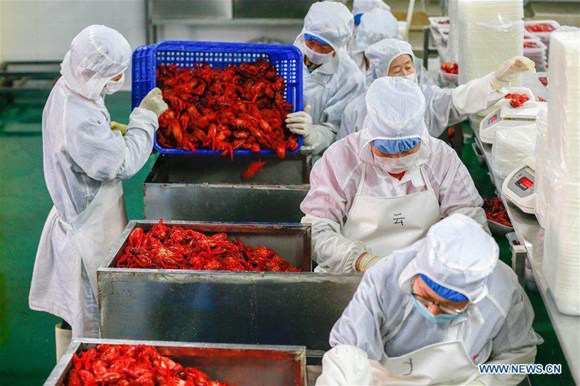
Workers process crayfish in Xuyi County, east China's Jiangsu Province, June 4, 2017. (Photo/Xinhua)
Business in China's crayfish restaurants get snappy as summer arrives. Spicy crayfish and beer is one of the most popular ways to detonate taste buds on hot nights.
China now has a crayfish market worth over 14 billion US dollars, according to Meituan, a leading online service provider for group-buy and food delivery in China. That accounts for around 4 percent of the overall Chinese foodservice market.
As of August 2016, there were at least 17,670 crayfish restaurants in China – three times the number of KFCs in the country, Beijing Morning Post reported citing data from dianping.com, a Chinese platform for food business reviews and information.
Why is crayfish so popular?
Chinese restaurants have developed dozens of different flavors in cooking crayfish, from spicy to salty to curried. When it comes to spicy ones, there are various choices, depending on the amount of chili.
Crayfish is a savory snack as well as a nice dinner. For around 15 US dollars per person, you can enjoy it with a couple of friends in a restaurant, or just pick up your phone and ask for some takeaway to gobble through while watching South Korean soap opera.
"Crayfish is a kind of food that once you eat it, you'll definitely get addicted. So of course the consumption of it keeps growing," said Lin Geng, a commentator for a news portal operated by Economic Daily.
From the perspective of restauranteurs, high profits, relatively low startup costs and standardized cooking all make crayfish a good choice for starting a business. Profits can reportedly reach as high as 80 percent while people just need a couple of thousand dollars to start a restaurant – much lower than starting many other businesses.
There are three major business models in China's crayfish industry: sidewalk snack booths, restaurants with crayfish as the flagship products, and online ordering.
The participation of Internet giants, including Alibaba, Jingdong and 163.com, has further expanded the crayfish market.
Tmall.com, a retail platform operated by Alibaba Group, established a crayfish restaurant in Beijing's foody Gui Street on May 25. A promotional activity attracted 500 customers and nearly 10,000 crayfish were eaten on that first day. Tmall staff told Beijing Morning Post that in the next three days, they sold about four million crayfish – both online and offline.
"If we piled all these crayfish together, it would be as high as 15 Eiffel Towers," they said.
Where are all these fishies from?
The crayfish, formal name Procambarus Clarkii, is native to the southeastern United States and has been introduced to other continents over the past few decades.
In 2003, the production of crayfish in China was less than 50,000 tons. But now China has grown into the world's largest producer of crayfish with an annual production of over 600,000 tons. That accounts for over 70 percent of the world's total, according to Xinhua News Agency.
Something fishy amid the prosperity
Food security is an issue that can't be overlooked in crayfish consumption. Scandals often make headlines in Chinese media, including stale and inadequately cleaned crayfish cooked into dishes.
"The quality of crayfish in China is quite uneven. We lack a unified production and regulation standard in the crayfish market," said food service researcher and pundit Zhu Danpeng.
The seasonal factor is another major hurdle for crayfish restaurants since they have to suffer from shrunken business in winter.
Fishing season for crayfish is usually from May to June. Most restaurants see booming business in summer, but a lot go bankrupt as they can't stand the loss in winter.


















































